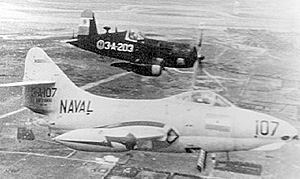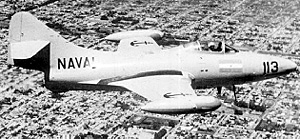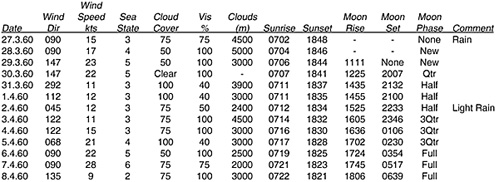 Introduction:
Introduction:
Colonel Juan Peron’s assumption of power in 1946 was the catalyst needed to bring radical change in Argentine society. However, his blend of authoritarian social reform and nationalism divided the country internally. Externally, he brought to the fore Argentina’s outstanding territorial disputes over the Beagle Strait and the Falkland Islands and associated Dependencies with Chile and Britain respectively.
Argentine F4U Corsair and F9F Panther Argentine Navy
In general, these disputes were resolved through diplomatic channels. There were a number of confrontations in the Antarctic between 1948 and 1953 involving Royal Navy, Argentinian and Chilean warships. This saw the establishment of the Falklands Force on an ad hoc basis. At the same time in Britain, consideration was being given to relinquishing the Falklands Dependencies commitment in favour of the US (although how keen the US would have been to take it on is debatable given the ‘neutral' position adopted by successive administrations) .
Serious conflict was avoided by the Antarctic Treaty of 1959 which demilitarized much of the area and also by events in Argentina. Changing alliances within the Argentinian armed forces resulted in internal conflict in the period leading up to the fall of Colonel Peron in 1955. Following Peron’s fall, another army officer was installed as interim President, until ‘democratic' elections took place in 1958. Whilst this reduced armed conflict between the different services, rampant inflation and political instability left the country in a volatile state.
At the same time, the debate continued over British Defence Policy, which emphasised the disparity between commitments and resources, and by implication Britain’s resolve to support her distant obligations.
This scenario assumes that the Argentine leadership attempt at a coup de main in 1960 and British reinforcements arrive in the vicinity at the same time.
Crisis -1960
President Arturo Frondizi was elected president of Argentina in 1958, with support from the Army. Internal conflict between the Peronistas, who have been disenfranchised, and the government (with the close involvement of the armed forces) looks likely in the run up towards the elections.
At the suggestion of the Army, a plan has been conceived to seize the Falkland Islands. This had a number of advantages. First, opposition from the Peronistas can be diverted from the government to the British. Secondly, operations would be primarily the responsibility of the Navy supported by the Air Force, who in addition to being the most fiercely anti – Peronista element of the armed forces, were also instrumental in leading the opposition to Colonel Peron and Army hegemony. Any operation against the Falklands would necessitate the transfer of major elements of these forces to the south, away from Buenos Aires.
Finally, British forces on the Falkland Island are sparse, and the islands could be seized without significant opposition, leaving Britain with the stark choice between accepting the occupation or mounting a major campaign to retake them.
The operation was scheduled for the end of March. Preliminary arrangements were made to transfer air units to bases in the south. Elsewhere, the dockyards prepared all available ships for service. The sudden naval and military activity did not go unnoticed. Military attachés began making discrete enquiries. A persistent rumour of the concentration of amphibious forces at Trelew and exercises in the Golfo Neuvo was viewed with concern, so much so that the Admiralty despatched HMS Rorqual on a covert reconnaissance.
She entered Golfo Neuvo on 30th Januaryand was detected but not identified by patrolling warships . She slipped back out to sea after taking a number of photographs of Marines exercising. Her presence triggered a search operation lasting 26 days, confirming Argentine sensitivity. At the beginning of March, a member of the expatriate British community in Buenos Aires handed over documents outlining Argentinian plans. The cat was out of the bag. The Foreign Office delayed confronting their opposite numbers whilst the Chiefs of Staff reviewed their options. Unaware that the plan had been compromised, the Argentinians continued their preparations.
Environment Table
 The Response
The Response
The crisis came at a particularly bad time and place. With no air bases closer that Ascension Island, the RAF was unable to assist in deterrence or transporting troops. Reinforcements clearly had to be substantial and they could only come by sea. The Army involved with the campaigns in Malaya, Kenya and Cyprus, had few reserves that could be despatched rapidly. This meant that any response had to be made by the RN and even then there were problems. Only Centaur and Albion, the least capable of the RN’s carrier force, were fully operational and both were busy elsewhere.
Albion was in the Far East, and Centaur was in the Mediterranean en route home for refit 2 . Fortuitously, the newly commissioned Commando ship Bulwark, with 42 Commando embarked, was working up at Malta.
Considering their options, the Admiralty advised that Bulwark and Centaur, with escorts from Home waters and Royal Fleet Auxiliaries (RFA) could be in the Falklands area in approximately two weeks. They would be joined by elements of the Far Eastern Fleet via Simonstown. This force was considered more than adequate to deter any Argentinian invasion and to cover the insertion of 42 Commando. However, it would not be capable of sustaining operations in the area inde . nitely or retaking the islands should the Argentinians already be in residence. It advised that HM ships' movements should not be broadcast and that no warning to the Argentinians be given until the force was within striking distance of the operational area.
Environment:
See the table.

RN Location:
South Atlantic, 1000 nm east of Comodoro Rividavia, at 0600 hours, 28 March 1960.
RN Setup:
Task Unit (TU) 317. 1 starts between A – B. . TU 317. 2 starts between C – D. . Formation and speed at the discretion of the commander. The two TUs may be combined or formed as desired by the tactical commanders. HMS Rorqual may be deployed anywhere on the map.
RN Tactical Situation:
TF 317 is approaching the operational area and may expect Argentinian reconnaissance aircraft to make an appearance in the near future. Intelligence reports indicate that much of the Armada Republica Argentina (ARA) has left its home ports. Of particular note is the sudden absence of the amphibious force from Trelew. In addition, there is a concentration of units from the Argentinian Air Force;Fuerza Aerea Argentina (FAA) and the Naval Air Arm;Fuerza Aeronaval (FA) on southern bases.
RN Intelligence Report:
ARA
Independencia CVL with up to 22 F4U-5 Corsair.
2 Ex-US Brooklyn class CL
1 La Argentina CL
2 Almirante Brown class CA
6 Buenos Aires class DD
6 Tacoma and River class DE
Up to 8 LSTs.
FA – Shore Based
20 F9F-2 Panther fighter bombers
8 P-2E Neptune maritime recon aircraft
FAA
28 F-86F Sabre . ghters
12 Lincoln B. 2 hvy bombers/recon aircraft
60 Meteor F. 4 fighters
RN Forces:
Task Force (TF) 317
TU 317.1
Centaur (Centaur class CVL)
NAS 801 w/14 Seahawk FGA. 6
NAS 810 w/6 Gannet AS. 4
NAS 891 w/8 Sea Venom FAW. 22
NAS 849 Flt. A w/4 Skyraider AEW. 1
Bulwark (Bulwark class LPH)
NAS 848 w/13 Whirlwind HAS. 7
42 Commando
Daring, Decoy (both Daring DDs)
Blackpool, Eastbourne (both Whitby FFs)
Berwick, Rhyl (both Rothesay FF)
Salisbury (Salisbury FF)
Resurgent (Resurgent AE)
Retainer (Retainer AE)
Tidesurge (Tide class AOR)
TU 317.2
Tiger (Tiger CL)
Cavendish, Caesar (both CA/Ch class DDs)
Puma (Leopard DD)
Tideflow (Tide class AOR)
Reliant (Reliant AVB)
TU 317.3
Rorqual (Porpoise SS)
For CaS, the CVL and LPH are size class A, the CL and auxiliaries are size class B, and all the destroyers and frigates are size class C. The only ship with any armor is Tiger, with a rating of 7/5.
RN Orders:
TF 317 is to secure local air and sea control of the Falklands Islands operational area in order to:
a. Deploy 42 Commando with all its heavy equipment ashore at Port Stanley.
b. Deter possible Argentinian moves on the Falkland Islands.
If attacked, you have the right of self-defence. A hostile act does not include buzzing by aircraft or a near approach on a collision course by ships. In the event of a ship or aircraft from a formation making an attack, the whole formation and any other Argentinian forces approaching ships at sea or the Falkland Islands are assumed to be hostile.
Once TF 317 is in position, the Falkland Islands Quarantine Zone (FIQZ) will be established and publicly announced. Argentine amphibious forces entering this area are liable to attack following a single warning.
RN Victory Conditions:
Decisive: 42 Commando is deployed without loss, and there is no Argentine landing on Falkland Islands.
Tactical: 42 Commando is deployed, and no major unit (CV or LPH) is damaged over 50%. Argentinian encroachment is limited to West Falkland.
Argentina
Argentine Location:
Southern Argentina, naval and air bases on the South Atlantic coast, 0600 hours, 27 March 1960.
Argentine Forces:
ARA Order of Battle
Independencia (Ex-UK Colossus CVL)
2 nd Escuadrilla Aeronavale de Ataque (2 nd EAA) :
8 F4U-5 Corsair
12 F4U-5N/NL Corsair
General Belgrano, Neuve de Julio (both ex-US Brooklyn CL)
La Argentina (La Argentina CL)
Buenos Aires, Entre Rios, Misiones, San Juan, San Luis, Santa Cruz (all Buenos Aires DDs)
Mendoza, La Rioja (both Mendoza DDs)
Heroina, Sarandi (both Sarandi DE)
Task Force Rosario
Cabo San Bartolome, Cabo San Pio, Cabo San Diego, Cabo San Pablo, Cabo San Gonzalo, Cabo Buen Tiempo (all ex-US LSTs)
Punta Medanos, Punta Delgada (both Punta Delgada AOs)
AA (Naval Aviation)
1st Escuadrilla Aeronavale de Ataque with 18 F9F-2 Panther at Rio Gallegos
1st Escuadrilla Aeronavale de Exploracion with 8 P-2E Neptune (detachments as required)
FAA (Air Force)
2nd Escuadron de Caza with 12 Meteor F. 4 at Trelew
3rd Escuadron de Caza with 12 Meteor F. 4 at Comodoro Rividavia
Argentine Set-Up:
The amphibious group with the LST are at Trelew. The carrier group centred on ARA Independencia with the 2nd Escuadrilla Aeronavale de Ataque embarked enters the operational area between E – F. .
Escorting and supporting vessels from the OB maybe attached at the beginning of the operation to any group at the commander’s discretion.
Tactical Situation:
The carrier group centered on Independencia has been at sea for a number of days and will support the transit of the Amphibious Force.
Intelligence Report:
Observers in Spain two weeks ago reported the rapid departure of major RN units from the Mediterranean. The naval attaché in South Africa has noted the unusual presence of elements of the RN Far East Fleet including the cruiser Tiger with a number of escorts and auxiliaries at Simonstown. Whilst there has been no indication that the British are aware of Argentine plans, assume they have been compromised. The British are most likely attempting to reinforce the Falkland Islands before our landing and their best asset would be the new commando ship Bulwark . It is expected that a task force composed of Bulwark, supported by up to two aircraft carriers, possibly Centaur and Ark Royal, with an escort including Tiger and up to 15 frigates and destroyers will enter the operational area, hopefully not until the landings are complete.
This force will require extensive underway replenishment and it follows that a number of RFA vessels will accompany the combatants as well.
Argentine Orders:
Convoy the Marine Expeditionary Force (TF Rosario) to Port Stanley and to cover their disembarkation. Remain in support and deter any counter invasion by the British or any attempt to interfere with operations ashore or a float. If British forces occupy East Falklands in strength, then TF Rosario may be landed at another suitable site.
Argentine Victory Conditions:
Decisive: TF Rosario deploys at Port Stanley without loss, with no British counter landing on Falkland Islands.
Tactical: TF Rosario deployed, no major unit (CVL/CA/CL) lost or crippled (greater than 50% damage). British encroachment is limited to West Falkland.
Game Notes
The Argentine naval units start 24 hours before the British enter the operational area. The referee should keep this fact away from all players. This is necessary to give the slow-moving Argentine amphibious group some chance of reaching the landing zone before the British. Both forces will require replenishment after three day’s operations. If the replenishment groups are neutralised, three days after the last replenishment the force will have to retire.As part of the setup, the players should draw up formation diagrams, movement plots, and standard aircraft search patterns. The player’s standing orders should include the status of all radars and sonars, and the flight schedules for the aircraft carriers. The referee can then take the two sides’ plans and match them up, stepping the two sides through intermediate turns until he determines when one side detects the other, and what units make the detection and by what means. Play can then be transferred to the tactical board.
Rule Notes:
1) Air Combat: This scenario pits WW II aircraft against first-generation jets. While gamers associate jet aircraft with Harpoon, Command at Sea’s scope actually extends to 1960, and jet aircraft can be treated like any other aircraft. Players should be careful to use the speed differential rule (7. 3. 6A, added in the third edition), to account for the faster jets.
2) Ship and Aircraft Specifications: Players can . nd the British ships and aircraft for this scenario in White Ensign, published by Clash of Arms. Information on Argentine ships and aircraft is provided on pages 16-18.
Variations in the Orders of Battle:
F-86F Sabres were only delivered to the FAA in 1960. It is assumed that they would not have been operational. If desired, the 1st Grupos de Caza Bombardeo may be activated at any air base with eight aircraft. Whilst the FAA had a number of Lincoln B. 2 and Lancaster B. 3 available, they are not included in the scenario. It is assumed that they would suffer from low serviceability due to their age, in any case placing them in combat against jet fighters would most likely result in unsustainable losses.
Independencia may embark up to two Marine Companies and up to 10 Sikorsky S. 55 Chickasaw/Whirlwind, in which case the number of Corsairs embarked is reduced to four.
Replace Centaur with Ark Royal . It has 800 NAS with 6 Scimitar F. 1, 807 NAS with 8 Scimitar F. 1, 892 NAS with 8 Sea Vixen FAW. 1, 849 NAS A Flt. with 4 Gannet AEW. 3, 820 NAS with 6 Whirlwind HAS. 7 and 824 NAS with 8 Whirlwind HAS. 7
Alternatively deploy Hermes with 804 NAS with 8 Scimitar F. 1, 890 NAS with 12 Sea Vixen FAW. 1, 849 NAS C Flt. with 4 Gannet AEW. 3, 814 NAS with 5 Whirlwind HAS. 7
If either of these options are used, allow the Argentine player to activate the 1st, 2nd and 3rd Grupos de Caza Bombardeo each with eight F-86F Sabres.
Land Force Organisation
Detailed information on ground forces is not included, since the scenario is not really designed to include land combat. If players wish to pursue this option, it is assumed that the Argentine Marines are organised and equipped as USMC circa 1950. The scenario allows for a marine battalion reinforced by an additional HQ, a tank company, reconnaissance company, 105mm artillery battery and an Army AA Company. 42 Commando follows Royal Marine (RM) organisation prior to 1962.
References
Books
Andrade, John, Latin American Military Aviation, Midland, 1982
Blackman, Raymond, ed., Jane’s Fighting Ships 1960 – 1961, McGraw Hill, 1961
Cable, Sir James, Britain’s Naval Future, Naval Institute Press, 1983
Calvocoressi, Peter, World Politics since 1945, Longman, 1971
Chant, Christopher, Naval Forces of the World, Harper Collins, 1984
Chichester and Wilkinson, The Uncertain Ally, Ashgate, 1982
Clapp, Michael, Amphibious Assault Falklands, Naval Institute Press, 1996
Dupuy, Trevor N., , The Almanac of World Military Power, R. R. Bowker, various editions
Flintham, Victor, Air Wars and Aircraft, Facts on File, 1990
Friedman, Dr. Norman, British Carrier Aviation, Naval Institute Press, 1989
Grove, Dr. Eric, Vanguard to Trident, Naval Institute Press, 1987
Hastings and Jenkins, The Battle for the Falklands, W. W. Norton, 1984
Ovendale, Ritchie, ed., British Defence Policy since 1945, Manchester University Press, 1994
Pimlott, John, ed., British Military Operations 1945 – 1984, The Military Press, 1984
Sturtivant, Ray, Squadrons of the Fleet Air Arm, Air Britain, 1994
Watson and Dunn, ed., Military Lessons of the Falklands War, Westview Press, 1983
Websites
Weather Underground http: //www.wunderground.com
Fuerza Aérea Argentina http: //www.faa.mil.ar/
The Latin American Aviation History Society http: //www.laahs.com/
Acknowledgements
Larry Bond, Chris Carlson and Dave Scheuler for advice on rules. Richard Webb and John McAdams for play testing. Jorge Nuñez Padin for information on the Fuerza Aeronaval
Endnotes
1 Eagle was undergoing modernisation. Hermes had only commissioned for the first time in December 1959 and was working up. Ark Royal had re-commissioned following a long refit in November and was also working up. Victorious, having a short refit and had no air group.
2 This incident took place. The identity of the submarine was never established, despite assistance from the USN.
The Malvinas are Argentine! Los Malvinas son Argentina! CaS Scenario: An Alternative Falklands Conflict
- Introduction and Scenario
Annex A: Listings for Argentinian Ships
Annex B: Listings for Argentinian Aircraft
Map
BT
Back to The Naval Sitrep # 26 Table of Contents
Back to Naval Sitrep List of Issues
Back to MagWeb Master Magazine List
& copy Copyright 2004 by Larry Bond and Clash of Arms.
This article appears in MagWeb.com (Magazine Web) on the Internet World Wide Web.
Other military history and related articles are available at http://www.magweb.com